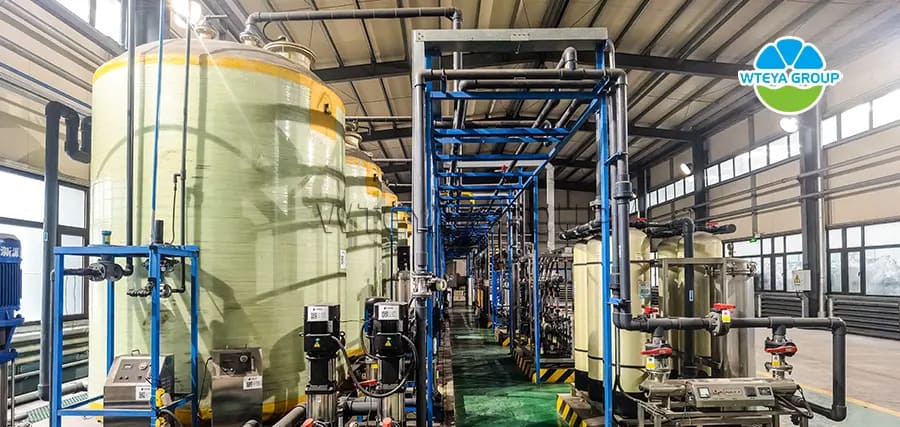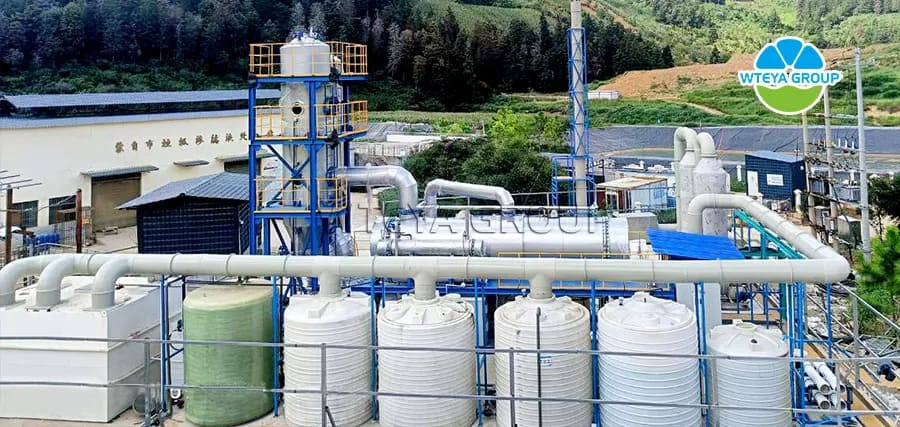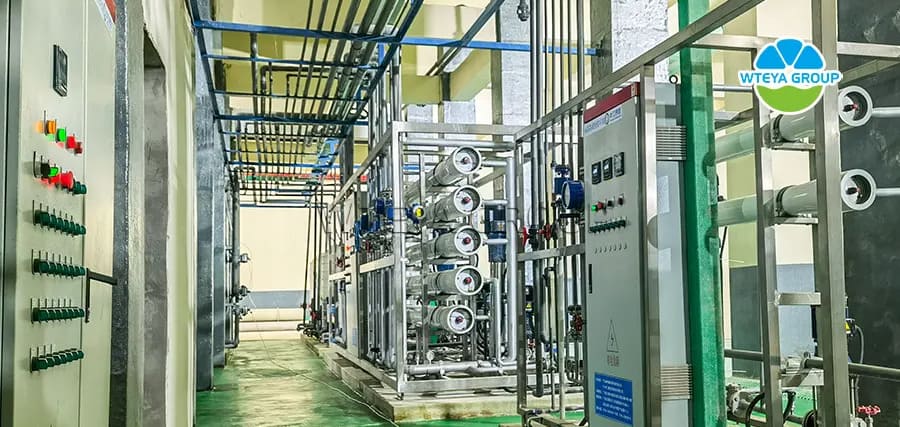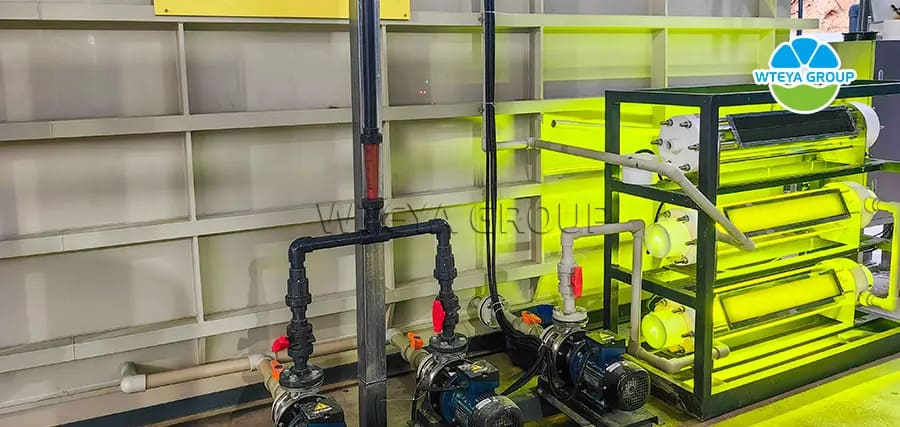New energy battery industry solutions
1. Integrated processing equipment
And in production
These devices are mainly used for mining, ore processing, including flotation, crushing, and crushing.
Technical Principles
The device mainly uses natural waste and coagulation technology, filters and liquid separation centrifugation technology to separate solids and liquids, and remove impurities.
What kind of results can we achieve
We can operate fully automatically without the need for anyone, saving a lot of labor; Removing suspension (SS) can achieve a processing efficiency of 80-95%.
2. Evaporation devices: such as MVR evaporation device, forced circulation device, low-temperature evaporation device, and multi effect evaporation device
And in production
Our equipment is mainly rich in metals, purifying and recovering sulfates and carbon; It can also be used for the treatment of high salt wastewater and the reuse of Chinese water.
The evaporation equipment in the material anode battery industry focuses on hydrogen metal processing, especially in raw material cleaning, solution concentration, by-product treatment, and wastewater treatment, as shown below:
(a) Purified and solution rich raw materials
Lithium salt concentrated solution: When you need to react with phosphate and lithium (such as lithium carbonate or lithium hydroxide), the battery anode material is produced, such as lithium iron phosphate (LFP). The evaporation device can be used to concentrate lithium solution, increase its concentration to better react with phosphoric acid, while reducing the energy of subsequent drying processes.
Crystal evaporation extraction solution: In the preparation of certain anode materials, such as the co precipitation process of producing lithium cobalt manganese oxide (NCM) precursors, it is necessary to convert the metal salts in the reaction into powder through crystal evaporation. The evaporation device in this process plays an important role in controlling the evaporation rate and crystallization conditions to ensure that the shape, particle distribution, and purity of the preceding particles meet the subsequent requirements of the sintering process.
(b) By product processing and resource recovery
Fluid recovery and regeneration: During hydrogen metal treatment processes, such as precipitation, extraction, and other steps, a fluid containing non reactive metal ions or by-products will be generated. The evaporation device can be used to concentrate this liquid, recover valuable metal ions, and reduce waste generation and resource reuse.
Salt wastewater treatment: In the production process of anode materials, salt containing wastewater can be produced. A water evaporator can evaporate wastewater to form crystalline salts and pure water. Crystalline salts can be further treated or reused, and pure water can be used in the production process or in standard waste to reduce the amount of wastewater and resources.
(c) Wastewater treatment and zero discharge (ZLD)
High salt wastewater treatment: The wastewater generated during the manufacturing process of battery anode materials may contain high concentrations of inorganic salts and heavy metal ions. Evaporation equipment (such as evaporators, MVR evaporators, etc.) can evaporate water from wastewater, producing pure and pure water. Concentrates can be further concentrated or extracted, and pure water can be reused in production processes or standard waste to reduce wastewater and resource consumption.
(4) Save energy and reduce emissions
Waste energy: The anode material of the battery generates hot waste, cold steam, or condensate, which can be used as a heat source for evaporation devices, effectively utilizing energy and reducing total energy consumption.
Reducing solid waste: Treating wastewater through evaporation equipment can greatly reduce the generation of solid waste (such as residue evaporation), lower the cost of solid waste treatment, and lower environmental pressure.
(5) Environmental restoration and historical management
Waste treatment: For enterprises producing high residual salt anode materials and heavy metal waste, steam equipment can be used as one of the management technologies to support environmental maintenance through centralized evaporation of waste, safe waste treatment, or resource recovery.
Technical Principles
MVR evaporator: The evaporator reuses the energy generated by its own secondary steam to reduce the demand for external energy. The operation process of MVR is to compress steam in the refrigeration compressor, increase temperature, pressure, and temperature, and then enter the heating and condensing system to utilize the potential temperature of steam. Except for the drive start, no steam is discharged from the second steam of the evaporator during the entire evaporation process. It is compressed by the compressor, causing an increase in pressure and temperature. The steam is then sent to the heating chamber to maintain liquid boiling.
Forced evaporation device circulation: The circulation of solution in the device mainly relies on the forced flow generated by external forces. The cycle speed is usually between 1.5 and 3.5 meters per second. Thermal energy and production capacity. The raw material liquid is pumped upwards from the bottom by a circulating pump, which flows upwards in the pipeline of the heating chamber. The mixture of steam and liquid foam enters the evaporation chamber and is separated. The steam is discharged from the top, the blocked liquid drops, is sucked into the conical bottom by the circulating pump, and then enters the heating pipe for further circulation. It has heat transfer coefficient, salt resistance, soil resistance, strong adaptability, and is easy to clean. Suitable for industries such as scale, crystal, temperature sensitive (low temperature), high concentration, and high viscosity, including chemically insoluble solids, food, pharmaceuticals, environmental protection technology, and evaporation recovery.
Cold evaporator: The temperature of the cold evaporator refers to the normal operation of woodworking evaporation at 35 to 50 ℃. After arriving at Ye Wei, solidification is carried out in each bucket of water, and the pump works to generate a vacuum. She is operated by the automatic water and evaporator - YaSuji, which generates heat to evaporate and heat the wastewater. The wastewater is in a zero vacuum state, and the temperature of the wastewater rises to around 30 ℃. The wastewater begins to evaporate before completion. After evaporation, YaSuJi sets the temperature to 35-40 ℃ and compresses the local area network with cold water to generate temperature. While the water rapidly evaporates, it cools the local area network through an expansion valve and wants to operate the heat absorption system after evaporation, rising to cold steam. The odor decomposition solution is dissolved in ChuShuiGuan, and of course, it is compressed and absorbed by YaSuJi ZhiRe to absorb both hot and cold, just reheat the wastewater. If the bubble is detected by the sensor during the evaporation process, the defoamer will automatically add defoamer. After one cycle is completed, the concentrate will be discharged (the cycle time can be set). After the evaporation cycle is completed, the compression pump stops working, focuses on the open pneumatic valve tube, pressurizes and evaporates, and focuses the hydraulic pressure on the barrel.
What kind of results can we achieve
Our company's evaporator can reach a concentration of 5-100 times under different water quality conditions, making it more energy-efficient, easy to adapt, highly automated, environmentally safe and stable. It has been widely used in industries such as chemical, pharmaceutical, food, and environmental fields.
3. Diaphragm separation equipment: DTRO, STRO, NF, etc
And in production
The diaphragm separation equipment in the production and processing of battery active materials has important application value in the following aspects:
(a) Purification and purification materials
Ion separation and concentration: Separation membrane technology, especially the nak filter (NF) and waterproof membrane (RO) layer, should be used for deep cleaning of lithium-ion salt solution battery materials required for anode production (such as lithium batteries, Liu Suan lithium batteries with CO2 saturation standby), effectively removing acidic and pure metal and organic pollutants, improving the quality of lithium-ion salt solution batteries, and providing fuel for high-quality anode composite materials.
(b) Solvent recovery and reuse:
In the process of manufacturing certain anode materials (such as hot solvents), organic solvents are used. Membrane separators can separate and recover wastewater or waste containing organic solvents, reduce solvent consumption, reduce waste production, and reduce environmental pollution risks.
(iii) Separation of intermediates and by-products
Extraction and grading: In the synthesis stage of extracting anode materials (such as hydroxides or carbonates), microfiltration (MF) or ultrafiltration (UF) membrane cleaning and grading can be performed to remove small impurities, improve particle distribution and extraction purity.
Desalination of by-products: In certain humid processes, by-product solutions containing a large amount of inorganic salts can be produced. Membrane separation technology can help remove these salts, allowing by-products to be reused or safely treated.
(4) Wastewater treatment and recovery
Reuse of wastewater: Wastewater from the manufacturing process of battery anode materials typically contains higher concentrations than metal ions and other toxins. Membrane separators, such as reverse osmosis or nanofiltration membranes, can be used for deep wastewater treatment, water reuse, reducing clean water consumption, and wastewater discharge.
Heavy metal recovery: For wastewater containing valuable metal ions (such as cobalt, nickel, manganese, etc.), ion exchange membranes or special separation membranes can be used as selective and recovery membranes, achieving dual goals of resource recovery and environmental protection.
Technical Principles
This process uses special membranes to separate components from liquid or gas mixtures. The basic principle of this technology is based on the differences in the speed and ability of different components passing through the membrane, which can be determined by the characteristics of the components, the characteristics of the membrane, the concentration differences on both sides of the membrane, pressure gradients, potential gradients or steam, or various factors. Membrane separation methods include microfiltration, ultrafiltration, filtration, reverse osmosis, and electrofiltration, each of which is suitable for different separation needs. For example, microfiltration and ultrafiltration filter molecules or solutions of different sizes based on the pore size of the membrane; Reverse osmosis refers to the pressure higher than the osmotic pressure of the solution, causing the solvent to pass through the membrane and block the solution; Electrodialysis is the selective utilization of ions in a solution using ion exchange membranes under the action of an electric field.
What achievements can we achieve?
Thin film separation equipment can be integrated into continuous and automated production lines to achieve continuous material separation, purification, and recycling, improve production efficiency, reduce batch quality changes, reduce energy consumption, comply with modern battery production, green production, and improve production efficiency.
Diaphragm separators are used in the manufacturing industry of battery anode materials for processing and important materials. A wide range of raw materials are mainly used in product anodes, intermediate and secondary separation, wastewater treatment and recovery, gas treatment, and promoting continuous optimization of production processes. They play an important role in improving the quality of anode materials, reducing costs, saving energy, reducing emissions, and achieving sustainable production. With the development and maturity of membrane separation technology, its future in the battery material industry will be even broader.
4. ECC oxidation equipment:
And in production
ECC catalytic oxidation technology is a new technology developed by the company, which uses catalysts to promote the oxidation reaction between organic pollutants and oxides (such as oxygen, ozone, hydrogen peroxide, etc.) under specific conditions. The final product is harmless or low toxic, achieving pollutant removal effect. The oxidation catalytic equipment varies according to different applications and objects, using different oxidants, catalysts, and reaction conditions to meet practical needs.
Technical Principles
ECC catalytic oxidation technology is a new technology developed by the company, which uses catalysts to promote the oxidation reaction between organic pollutants and oxides (such as oxygen, ozone, hydrogen peroxide, etc.) under specific conditions. The final product is harmless or low toxic, achieving pollutant removal effect. The oxidation catalytic equipment varies according to different applications and objects, using different oxidants, catalysts, and reaction conditions to meet practical needs.
What kind of results can we achieve
The efficiency of company type organic removal products (CODcr) exceeds 80%, and some can exceed 95%. It can also significantly reduce the heating temperature of the reactor, the probability of steam device bubbles, and system membrane fouling.











